| Published
on 2
Aug 2017 |
All rights reserved.
|
|
|
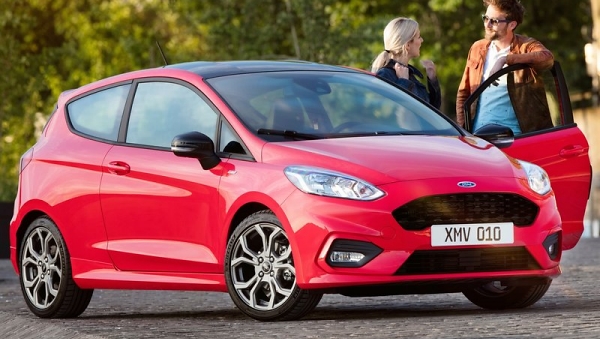
|
|
Replacing
a long-time winner is always difficult, but Ford has managed to do that
with the new Fiesta.
|
|
Since 2008, Ford Fiesta
has been our favourite B-segment small car. It might not be the most
practical or the best built – those should be Honda Fit/Jazz and VW
Polo respectively – but it is definitely the most fun to drive. Its
sharp handling, well-balanced chassis, keen steering and supple ride
make it the best companion to keen drivers. It also looks handsome and,
from 2013, offers the industry’s best 3-cylinder engine, i.e. Ford’s
1.0 Ecoboost. Meanwhile, its hot version ST and ST200 consistently
topped our A/B-segment hot hatch chart. In a nutshell, the outgoing
Fiesta was a great car. No wonder it lived for nearly 9 years. Up until
its retirement, it was still Ford’s best-selling car in Europe, and the
3rd place in the overall European sales chart, just behind VW Golf and
Polo. That was an incredible achievement for a car so old.
As the car has been so important to Ford Europe, the new generation
Fiesta carries a lot of expectation. It has to extend that lead in the
class and carry over the sales momentum. It has to respond to the
requirements for reducing emission and the demand for higher build
quality and more comfort. It also needs to take care of buyers who
might be looking to small crossovers, especially when Ford Ecosport is
not performing very well. Most important to us, however, is that it
must not let us down in terms of ride and handling. So many modern cars
sacrifice driving fun in the name of “maturity”. Renault Clio IV is an
unfortunate example. While comfort and refinement sell, it is driving
excitement that wins headlines in motoring publications and new media.
Any backward step, even a small one, could damage the reputation of a
respected label. Thankfully, the new generation Fiesta does not
disappoint.
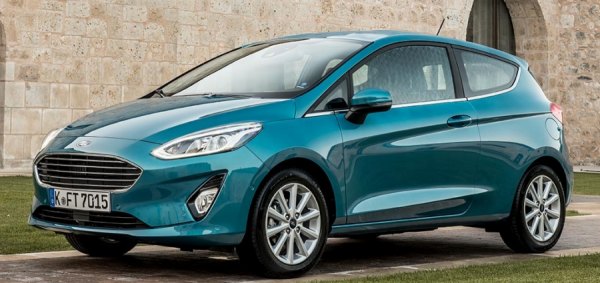
|
|
Unlike
rivals, Ford has retained the choice of 3-door body, which is good
because it has always been more stylish.
|
|
Obviously, Ford is keen to keep the successful formula of the outgoing
Fiesta. The new car looks so familiar that you might confuse it with a
heavy facelift. Its sharp profile is kept. Ditto the Aston-Martin nose
– something inherited from the era when Aston was still part of the
Ford group. The biggest change is a wider tailgate, which necessitates
the taillights to be changed from vertically to horizontally mounted
and half-split by the tailgate. This is designed to ease luggage
loading, of course. Unlike Renault Clio, Seat Ibiza and the new
Volkswagen Polo, Ford has retained the choice of 3-door body alongside
the more popular 5-door, which is good because 3-door has always been
more stylish (and a tad lighter). The new Fiesta also offers more
styling variants than any of its rivals. There are 5 distinctly looking
trims: Zetec (regular), Titanium (smart), Vignale (luxury), ST-Line
(sporty) and Active (high-riding crossover), each with different nose
treatment and other cosmetic deviations. Hopefully they will widen the
market presence and earn more cash.
The new car is about 70mm longer than before, but most of that is spent
to the longer front overhang. It is just 13mm wider and a tad lower.
Its wheelbase is stretched by merely 4mm, yet that is purely the result
of revising rear suspension geometry rather than altering hard points.
At 2493mm, its wheelbase is shorter than pretty much all rivals now
(with the exception of Suzuki Swift, which is a much cheaper car then).
The new Ibiza and Polo, its strongest rivals, both run a wheelbase of
2564mm. They are considerably wider than the Fiesta, too. Naturally,
this reflects in the interior. The Fiesta’s cabin doesn’t feel as
spacious as those Volkswagen group twins. While the front is still
spacious enough for anyone, the rear seats are tight for regular-size
adults and more suitable to children, even though Ford claims that
thinner seats free up 16mm rear legroom compared with the old car. It
is not quite a true 4-seater, although that is not a sin for this class.
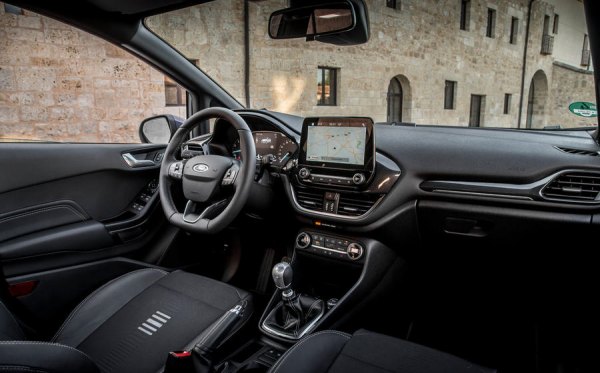
|
|
The
interior looks more tasteful, ergonomics greatly improved, but
perception of quality still fails to match the VW group cars...
|
|
However, the cabin’s layout, technology and quality are all noticeably
improved. The Nokia-style array of buttons on center console has
finally given place to a new-age iPad touchscreen and the
sleek-operating
Ford Sync3 system. Not only the interior looks more tasteful and less
busy, but ergonomics is greatly improved. The driving position is
excellent, with plenty of adjustment. More soft-touch plastics are used
on the dash, but the door panels and grab handles are hard, scratchy
and hollow, so the perception of quality fails to match the new
Volkswagen Polo, or even Seat Ibiza.
The car is built on an updated version of the existing Global
B-platform, which underpins also the B-Max and KA+. It is an old dog,
but this dog does play tricks that its rivals don’t, so we should not
be disappointed. Moreover, the chassis is now constructed out of more
high and ultra-high-strength steel, using more laser welding and a
stiffer front subframe. The result is a 15-percent bump in torsional
rigidity. Meanwhile, the car’s slightly more slippery shape lowers drag
coefficient to 0.29. Both factors reduce NVH and boost running
refinement. Handling is improved by using wider tracks (+30mm up front
and +10mm at the rear), stiffer front anti-roll bar and a new electric
power steering whose friction is reduced by 20 percent. ST-Line uses
stiffer springs and dampers and has its ride height lowered by 10mm,
while Active is jacked up by 18mm. All cars feature rear disc brakes,
finally.
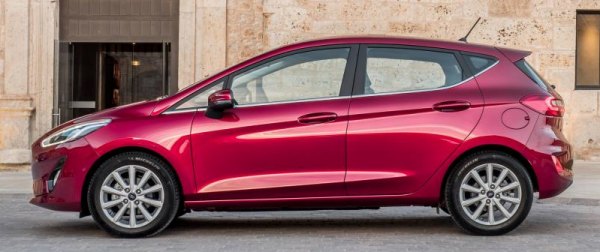
|
|
The
Global B-platform is an old dog, but this dog does play tricks that its
rivals don’t...
|
|
In the engine bay, the award-winning 1.0-liter Ecoboost 3-cylinder
direct-injection turbo now consists of 3 states of tune: 100hp, 125 hp
and 140 hp. In particular, the 100 hp version is now available with
cylinder cut-off technology, which shuts down one of the cylinders at
lighter loads to save fuel. To counter the resultant vibration, it
needs to have the engine strengthened, upgrade its vibration-dampening
clutch and counter-balancing flywheel to suit. Fuel consumption can be
reduced by 6 percent in European cycle as a result. Meanwhile, the 140
hp engine feels quite punchy at the top end, taking 8.5 seconds to go
from 0-60, which is the territory of warm hatches. No matter which
version, the 1.0 Ecoboost engine is smooth, flexible and eager to rev,
which is a remarkable achievement especially considering its lack of
balance shaft. Compared with Volkswagen’s 1.0 TSI engine, it is quieter
and sweeter revving. The 3-cylinder thrum is characterful but it is
generally muted most of the time on road, thanks partly to the use of a
6-speed manual gearbox. The latter's gearshift is slick, swift and
precise, whereas ratios are well spread, not overly biased towards
cruising economy. This powertrain combo brings a lot of fun.
At the lower end, there is a newly developed naturally aspirated,
1.1-liter version of the triple. It employs Ti-VCT (twin-VVT) but no
direct injection to keep cost down. It produces either 70 hp or 85 hp,
the latter is more powerful than both Volkswagen 1.0 (75 hp) and PSA
1.2 Puretech (82 hp). That said, as long as you can afford, the
Ecoboost is always the irresistible choice. Likewise, 1.5 TDCi diesel
lives under the shadow of 1.0 Ecoboost.
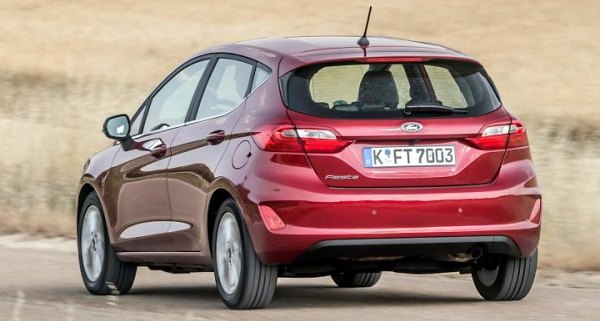
|
|
The
suspension absorbs the impact of bumps, pot holes and everything
brilliantly...
|
|
Once again, the Fiesta excels in the twisty. Its chassis feels agile
and well-balanced like no others in the class. It offers good front-end
grip to resist understeer. Although lift-off oversteer is generally out
of scope for the cooking version (which should return on the
high-performance ST, hopefully), the Fiesta’s precise, well-weighted
controls – no matter steering, brakes, throttle or gearshift – are the
best companions to keen drivers, making it the most fun-to-drive
supermini again. The steering is lighter than before, but it is
accurate, progressive and offers just enough feedback to shame most
other rivals’ electric racks. Although it is not yet a hot hatch, its
body roll is well contained, especially the ST-Line with stiffer
suspension. Most impressive, this does not come at the expense of ride
comfort. In fact, the Fiesta’s suspension absorbs the impact of bumps,
pot holes and everything brilliantly, resulting in a fluidity and
quietness so far none in the class could match. The cabin is well
isolated from the outside world. Such a combination of great control
and suppleness is beyond the reach of Seat Ibiza, currently its
strongest competitor.
I suspect the new VW Polo could challenge the Fiesta for quietness, but
it is unlikely to threaten the Ford in driving excitement and ride
composure. Yes, the Fiesta might not have the most modern packaging or
a build quality as good as the VW group cars, but when the driving
experience is taken into account, it is still the best car in the
segment.
|
Verdict:      |
Published
on 18
May 2018
|
All rights reserved.
|
|
Fiesta ST
|
|
It
might be common in the days of Volkswagen Golf GTI Mk1 or Peugeot
205GTI, but in the past 2 decades or so very few budget cars could be
as entertaining to drive as the last Ford Fiesta ST. It proves that
Ford Europe still knows how to build driver’s cars. However, to
replace such a legend is not easy. Customers demand more refinement,
safety and comfort, while governments mandate tighter CO2
emission
standards. How to retain old-school fun with a green, safe and refined
package becomes a big headache to car makers – and they usually fail to
achieve. Can the new Fiesta ST be an exception?
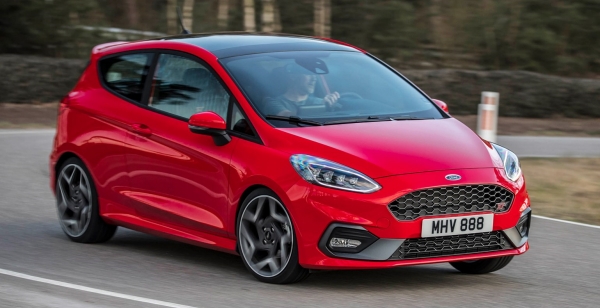
|
|
While
the 1.5 Ecoboost is probably better than most rivalling engines
nowadays, sadly, we moan that history won’t go back.
|
|
In terms of styling, I am not totally convinced. The old Fiesta ST was
quite striking on the road with its sharp nose and aggressive lights.
In comparison, the new car has added some maturity to the detailed
design but its flatter tailgate and horizontal taillights are
particularly dull to look. Its conventional exhaust and lukewarm
diffuser fail to inject sparkles either. You might say I am picky, but
I do think it could be more stylish.
Inside, apart from the optional
Recaro buckets there is not much to separate the ST from
lesser models. Ford should have learned from Volkswagen Up GTI, which
is cheaper yet feels more special inside and outside. That said, the
Fiesta's new interior is vastly improved in terms of quality,
electronics and ergonomics. Its driver seat is finally mounted low
enough, correcting one of the biggest flaws of the old car.
Under the bonnet, you will find an even bigger change: instead of the
outgoing 1.6-liter four-cylinder turbo, the new car has turned to a
1.5-liter three-cylinder turbo, which cuts fuel consumption by 20
percent. 6 percent of which is contributed by the new cylinder
deactivation function, which shuts down the middle cylinder at lighter
loads. Volkswagen 1.5TSI engine has this feature long ago, but Ford is
the first to apply it to a 3-cylinder engine as well as a hot hatch. As
for output, the slightly smaller capacity and smaller cylinder count
hurt nothing. It produces the same 200hp and 214lbft as the last ST200
(although the latter had an additional overboost). Top speed and
0-60mph improve slightly to 144mph and 6.2 seconds, matching Peugeot
208 GTI by Peugeot Sport.
In the chassis side, modifications are more extensive than expected.
The monocoque has additional bracings underneath to raise torsional
rigidity by 8 percent. The steering rack is geared to be 14 percent
quicker than the old car’s. The front track is widened by 10mm, or 48mm
versus the old car’s. The rear end's torsion beam gets stiffer, and it
is suspended on innovative force vectoring springs, a kind of specially
winded spring that produces lateral force to counter cornering force.
This means the rear suspension of Fiesta ST can resist roll better yet
without resorting to very stiff bushings (which hurt ride quality) or a
Watt’s link (which adds 10kg weight). Besides, the dampers have been
upgraded to Tenneco’s Frequency Selective Dampers, a kind of 2-mode
mechanical adaptive dampers (believed to be licenced from Koni, which
used to be known to us as Amplitude Selective Dampers). It should be
able to deal with both high frequency and low frequency bumps better
than before. Also new to the Fiesta ST is the optional Quaife
torque-biasing LSD, an answer to the Torsen LSD of 208 GTi by Peugeot
Sport. Last but not least, it is available with selectable driving
modes (Normal, Sport and Track) for the first time.
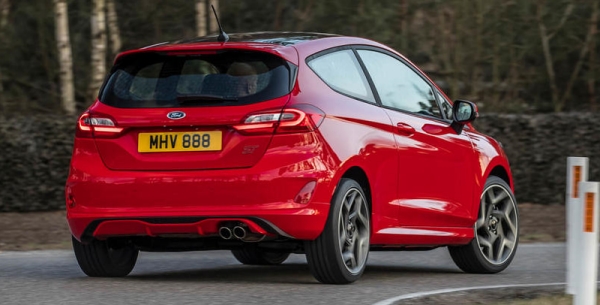
|
|
The
adjustability and fun are still there, but you might need to push
harder to access them now...
|
|
On the road, the new 3-port engine is a mixed bag. It offers more power
and a wider torque spread, making day to day driving more relaxing.
Turbo lag is reduced further, while the transition between 3 and
2-cylinder mode is imperceptible. On the downside, it has lost some
willingness at high revs. Getting close to 6000rpm and it feels
strained, accompanied with more noise than thrust. If you enjoy a
sweet-revving manner, the supercharged four of Toyota Yaris GRMN would
be a better bet. Unlike the latter, the Ford Ecoboost triple has a
rather slow throttle response, which is evident when you lift off
throttle and wait for the rev to drop. This is because it needs a
heavier flywheel to smooth out the power pulses at lower revs. As for
sound, it is okay, if not especially memorable. The 3-cylinder exhaust
beat is quite characterful but again it gets gruff at the top end. Ford
uses an exhaust flap, some engineered pops and crackles and sound
synthesizer (produced through speakers) to enhance the noise. Even so,
you won’t be tempted to rev the engine as you would with a classic Alfa
twin-cam. While the 1.5 Ecoboost is probably better than most rivalling
engines nowadays, sadly, we moan that history won’t go back.
Comparatively, the gearbox is more successful. Shifts are slick and
positive, ratios are close enough.
What makes the Ford outstanding is the chassis. Its ride is still quite
firm, but definitely more forgiving than the old car. (BTW, cruising
refinement is improved as well, thanks to the Fiesta’s lower wind, road
and engine noise.) The 2.0-turn steering is very quick and precise. The
car’s body control and poise are even better. Ditto the superior grip
offered by the Michelin Pilot Super Sport tires. In addition to the
LSD’s traction, the Fiesta ST becomes a more serious machine for
attacking the twisty. Has it lost the talent of throttle steer? No, you
can still carry a lot of speed into corner, lift off throttle and move
the tail out, use trailing throttle to adjust the balance. The
adjustability and fun are still there, but you might need to push
harder to access them now, since the new ST has higher cornering
limits. Inevitably, this means you won’t be able to enjoy the
adjustability as often as before on public roads. It is a price you
need to pay for the more serious performance. That said, Ford is still
more committed to throttle steer than anyone else in the hot hatch
world, including Peugeot. Because of this, the new Fiesta ST is still
worth the highest praises, even though its engine and styling are not
perfect.
|
Verdict:     
|
|